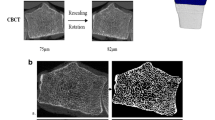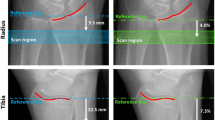Abstract
The purpose of the present study was to evaluate the accuracy of peripheral quantitative computed tomography (pQCT) in measuring the thickness of the radial cortex. Thirty left forearm specimens were scanned on an XCT 960 Stratec pQCT device using a 2.5 mm thick slice at the junction of the middle and the distal third of the radius. Cortical and trabecular areas were assessed using a threshold procedure; cortical thickness was subsequently calculated assuming a circular ring model for the radius. Cortical thickness was also measured on the true shape of bone using an iterative contour detection procedure. Subsequently 2.5 mm thick resin-embedded cylindrical radial specimens, matched with the site of pQCT examination, were obtained and contact radiographs were performed. After tenfold magnification, the cortical and trabecular areas of the specimens were measured using computerized planimetry and cortical thickness was calculated assuming a circular ring model. The cortical thickness could be assessed by pQCT in all cases using the threshold algorithm (mean (SD) 2.51 (0.58) mm) and in 21 cases could be directly measured on the true shape of bone (2.62 (0.32) mm). The cortical thickness of the specimens showed good correlation and high proportionality with that measured using pQCT with either the threshold algorithm (r=0.941, slope=0.976) or the iterative contour detection procedure (r=0.883, slope=0.987). In conclusion, pQCT is able to assess the thickness of the radial cortex, at the junction of the middle and the distal third, with high accuracy.
Similar content being viewed by others
References
Mazess RB. Fracture risk: a role for compact bone. Calcif Tissue Int 1990;47:191–3.
Carter DR, Hayes WC. Bone compressive strength: the influence of density and strain rate. Science 1976;194:1174–5.
Myers ER, Hecker AT, Rooks DS, Hipp JA, Hayes WC. Geometric variables from DXA of the radius predict forearm load in vitro. Calcif Tissue Int 1993;52:199–204.
Ruegsegger P, Durand E, Dambacher MA. Localisation of regional forearm bone loss from high resolution computed tomo-graphic images. Osteoporosis Int 1991;1:76–80.
Schneider L, Borner W. Effect of systemic pathologic condition on bone size but not on bone density. Bone Miner 1994;25:39.
Derisquebourg T, Dubois P, Devogelaer JP, Meyse E, Duques-noy B, Nagant de Deuxchaisnes C, et al. Automated computerised radiogrammetry of the second metacarpal and its correlation with absorptiometry of the forearm and spine. Calcif Tissue Int 1994;54:461–5.
Hsu E, Patwardhaw AG, Meade KP, Light TR, Martin WR. Cross-sectional geometrical properties and bone mineral contents of the human radius and ulna. J Biomech 1993;26:1307–18.
Thompson DD. Age changes in bone mineralisation, cortical thickness, and haversian canal area. Calcif Tissue Int 1980;31:5–11.
Louis O, Van den Winkel P, Schoutens A, Osteaux M. Size of cortical bone and relationship to bone mineral density assessed by quantitative computed tomography image segmentation. Invest Radiol 1993;28:802–5.
Schneider P, Borner W. Periphere quantitative Computertomo-graphie sur Knochenmineralimessung mit einem neuen speziallen QCT-Scanner. Nuklearmediziner 1988;11:145–52.
Butz S, Wuster C, Scheidt-Nave C, Gotz M, Ziegler R. Forearm BMD as measured by peripheral quantitative computed tomography (pQCT) in a German reference population. Osteoporosis Int 1994;4:179–84.
Hangartner TN, Gilanz V, State W. Constant cortical density is a requirement for the accurate measurement of cortical thickness by CT. Bone Miner 1994;25:S4.
Louis O, Van den Winkel P, Covens P, Schoutens A, Osteaux M. Excision of a trabecular ROI from resin-embedded vertebrae: report on a computer assisted method. Phys Med Biol 1993;38:855–61.
Author information
Authors and Affiliations
Rights and permissions
About this article
Cite this article
Louis, O., Willnecker, J., Soykens, S. et al. Cortical thickness assessed by peripheral quantitative computed tomography: Accuracy evaluated on radius specimens. Osteoporosis Int 5, 446–449 (1995). https://doi.org/10.1007/BF01626606
Received:
Accepted:
Issue Date:
DOI: https://doi.org/10.1007/BF01626606




